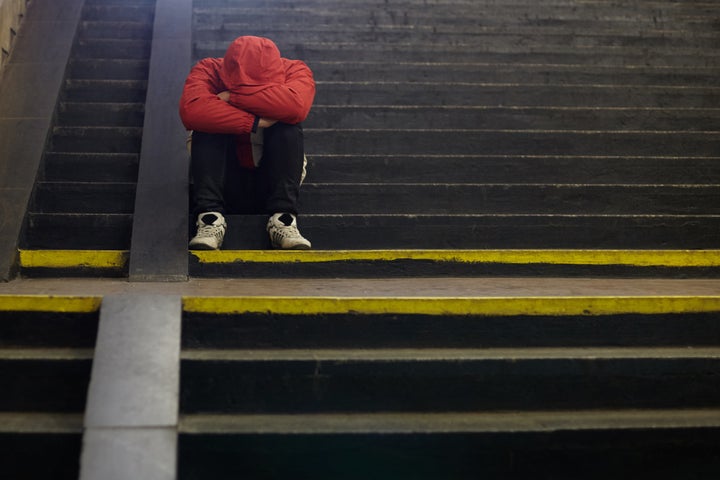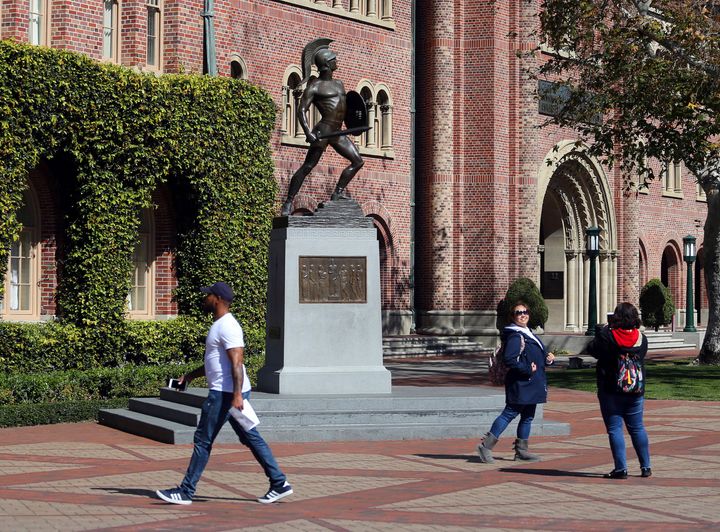LOS ANGELES ― Yoojin Park, a junior at the University of Southern California, is a biology major and a tutor for a program that matches undergraduates with local elementary schools. And as of November of last semester, 21-year-old Park is also a sex worker.
Since escaping an abusive home three years ago, Park has bounced between student housing and homelessness, first at a small school in the Bay Area and now as a transfer student at USC. Park is a pseudonym used to protect her identity, but her story is one of many that go unnoticed on the sprawling, sunny campus of USC ― a school nicknamed the “University of Spoiled Children,” whose offerings include a $6 cupcake vending machine.
“Every fucking year I deal with homelessness,” she said. “And it’s such a teetering thing. Like, ‘I’m going to be homeless; no, I’m not. I’m going to be homeless; no, I’m not.’”
She spent one summer break sneaking in and out of a friend’s dormitory in the Bay Area and another summer on the couch of a friend’s brother in Los Angeles. Last December, Park realized she wasn’t going to be able to pay her rent while holding two on-campus jobs and looking for a third. Her schedule with two jobs and a full course load made fitting in a third job all but impossible.

Park turned to SeekingArrangements.com.
“I found a sugar daddy,” Park said. “If I didn’t do that, I would have been homeless. I would be in the tents by the highway.”
The site connected Park to a 60-year-old divorced doctor who gives her money in exchange for regular dinner dates. The money ensures she can pay her rent each month.
“He’s like the top-off scholarship,” Park said.
But Park’s struggles are hardly solved. The client controls how they meet and how much he pays. Currently, her savings account holds $3.
“I would be homeless without him,” Park said. “As a feminist, I hate saying ‘without him,’ but I have to be honest. That’s just how it is.”
In The Same Boat
Though Park’s case is dramatic, it is emblematic of a larger trend at USC. Though attempts to survey the student population have yet to yield concrete numbers, discussions with staff and student leaders indicate hundreds of students have issues with housing stability.
“What I can tell you right now is that a significant amount ― an alarming amount ― of students said they faced an issue of homelessness in the last year,” said Mai Mizuno, a senior at USC and a representative of Undergraduate Student Government, citing an exploratory survey distributed to some members of the student body.
“It’s such a teetering thing. Like, ‘I’m going to be homeless; no, I’m not. I’m going to be homeless; no, I’m not.’”
The phenomenon at USC echoes nationwide trends. More than a third of college students reported a lack of stable housing throughout their undergraduate terms last year, according to findings from the Wisconsin HOPE Lab, a research project dedicated to analyzing accessibility in higher education.
“There’s this idea that you can mow lawns and you would be able to save up enough money to go to school for the year,” said Anthony Hernandez, a researcher for HOPE who worked on the report. “It’s a harmful narrative.”
Tuition at USC for undergraduates is currently $55,320, with a 3.5% increase recently announced for the 2019-20 academic year. And as housing costs in Los Angeles also continue to rise, Park’s struggle to stay afloat could become increasingly common.
USC has been embroiled in a college admissions scandal since last month, as dozens of wealthy parents were accused of paying bribes and cheating their children’s way into elite colleges. Authorities charged actress Lori Loughlin with committing crimes to help her daughter, a YouTuber who once said she was more interested in partying than class, get into USC.
But USC also has a notably large population of students with a high level of financial need, a population often erased in public perceptions of the school. First-generation college students comprise 17% of the current freshman class, and almost two-thirds of students in the 2017 freshman class received some form of financial assistance.
“When people see USC, and the stereotype of USC, it’s not that at all,” Mizuno said.
In higher education across the country, a push for more first-generation and high-financial-need students has broadened access to a higher education system still oozing with elitism. Often, though, students from historically disenfranchised backgrounds are admitted but not provided necessary resources for academic and personal well-being. Higher enrollment of low-income and high-financial-need students doesn’t always keep these students from hunger or homelessness.
There’s also a great deal of stigma against asking for help with homelessness.
Few students come into the office that provides alternative housing resources, said Lynette Merriman, the associate vice provost for campus support and intervention.
“They don’t want anybody to treat them differently,” Merriman said. “They just don’t want people to know.”

Invisible Students
Three years ago, two students approached Catherine Quinlan, the dean of USC Libraries, to ask if they could stay overnight in Doheny Memorial Library, which closes at 10 p.m. Quinlan assumed they wanted to use the library to study all night before finals and said no. The students explained that they didn’t need it to cram ― they had no other place to sleep.
It was eye-opening for Quinlan. She contacted other administrators and eventually joined the steering committee for a new initiative on eliminating homelessness at USC. When she saw one of the students a year or so later, they were embarrassed that Quinlan recognized them. She cites the “shame factor” as the biggest obstacle to tackling housing instability among students.
For Park, the library was also a refuge. She worked the graveyard shift at Leavey Library, the lone campus library open 24 hours a day, which gave her a place to stay at night. Around 3 a.m., most students would clear out, but she noticed one person who was there every night.
He always wore a hoodie, which he would sleep inside of, and he brought a standing lamp with him to his constant perch on the second floor. One time, Park saw him outside of the library on campus at 4 a.m.
“More than a third of college students reported a lack of stable housing throughout their undergraduate careers last year.”
She hesitated to ask him if he was homeless, too. “He was sleeping anyway,” she said.
That even Park held back from asking him hints at the difficulty in identifying and helping vulnerable students.
Though it’s not always easy to spot a student experiencing homelessness, there are many ways to address the root problems ― which, even at USC, are the same that are causing housing insecurity and homelessness nationwide.
“It has so many different heads that keep popping up,” said Brenda Wiewel, the director of the USC Initiative to End Homelessness. “If we solve it here, we’ve solved it everywhere.”
At USC, a campus known for its outward displays of wealth, the first step may be just making the problem less invisible.
“How do you bring up the fact that you haven’t eaten for two days when your classmates are talking about their spring break trip to Paris?” Park asked. “When I first opened up about my struggles in class, people thought I was joking.”
“I just want people to know that I’m here,” she continued. “That I’ve been homeless, that I’m a sex worker and I’m amongst you.”